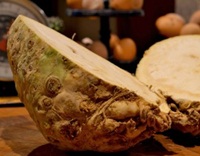
If you’re shopping in supermarkets this winter you may have noticed a ‘new’ vegetable on the shelves – a strange-looking root veg that looks like a misshapen ‘turnip’ (swede), a vegetable the creators of Dr Who could easily have crafted into an alien creature…

If you haven’t come across Celeriac before, do look out for it as it makes one of the tastiest soups and creamiest purées I’ve tasted in a long while and can highly recommend you try it.
Celeriac has been available for some time in farmers markets and is certainly not new, having been grown and then introduced into *Britain in the 18th Century from the Mediterranean area. It’s rich in Vitamin K which helps bone mass (100g of celeriac can provide over a third of our daily allowance), as well as a healthy dose of fibre. I bought a beauty from a local grower in Kilkenny last Christmas, but it’s the first time I’ve seen these particular roots in local stores.
I’ve mentioned before that vegetables live in families and this deceptively flavoursome vegetable is related to carrots, parsnips and celery – all members of the Apacaea family, a group of vegetables that Scientists at the University of Newcastle Upon Tyne are currently researching in relation to their positive effect on cancer and inflammatory diseases. According to the University:
Polyacetylenes are natural plant chemicals that protect the plant from attack and only occur in vegetables of the carrot family and a few other closely related species such as ginseng.
Celeriac, as its name suggests, tastes like a rootier, milder version of celery.
Growing Celeriac
Celeriac is a slow grower so patience is a virtue, though once harvested will store for several months if kept cool and dry. It can be a tad tricky to grow successfully as it doesn’t like the weather to be too hot (not usually a problem here), it needs lots of regular watering (which can cause fungus if it’s warm and humid) and is very shallow rooted (it’s important the roots aren’t disturbed).

To give celeriac the best chance, it’s recommended by some gardeners to sow the seeds inside in seed trays 10 weeks before last frosts, before planting out in well prepared soil. In Ireland that would be around the end of February and I should add at this point that I’ve yet to successfully grow this vegetable. I did come close but it never quite developed enough root before I got fed up waiting and pulled it up. Never one to give in, this year I’ll be trying the seed tray method with a liberal dash of finger crossing and will let you know how I get on. I might also try growing a few in our polytunnel, which is where our carrots fare best as the soil inside isn’t as heavy as outside.
Cooking Celeriac

Celeriac le Campagne way: warm celeriac mousse, pickled pear, celeriac chutney, hazelnut dressing & Parmesan crisp
When I spotted a large box of celeriac in the local store before Christmas I reached out for a couple in case they sold out never to be replaced. I’ve since added them to my weekly shopping basket. It’s amazing how appreciative we become of food when we know how tricky it is to grow.
Celeriac can be pureed, mashed, made into soup, steamed or boiled, just like other root veg. I’ve written a few simple soup recipes on this blog before, but here’s another for the collection.
Simple Celeriac Soup Recipe

Serves 4 – 6
Half a celeriac root, peeled and chopped
Shallot, peeled and chopped
Garlic clove, peeled and crushed
Half a potato peeled and chopped
1.2 ltr water
Vegetable stock cube
Salt & freshly grated pepper
Spray of oil or a dash of butter
Melt the butter or spritz the base of a large saucepan with oil and cook the shallot gently until it begins to caramalise then add the garlic, celeriac and potato, stirring all the ingredients together.
Cook for a couple of minutes on a medium heat then add the vegetable stock then season with salt and pepper to taste. Turn up the heat, bring the soup to a boil, then simmer for around 20 minutes until the vegetables are soft.
Remove the pan from the heat, pour the soup carefully into a liquidiser and blitz until all the ingredients are combined.
This is a thick soup so if you prefer it a little thinner, add some milk or hot water to thin it out. You could also try adding a chopped apple or carrot into the pan to simmer with the vegetables to give it a different flavour.
Once liquidised, pour the soup into bowls to serve.
Nutrition for 4 people per person: Calories 65, Fat (g) 1.6, Carbs (g) 12.1, Protein (g) 1.9
Have you tried growing or eating celeriac? What’s your verdict? How do you eat it?

Dee Sewell – a horticulturalist and certified trainer who started Greenside Up in 2009 and teaches people how to grow vegetables. Dee specialises in working with community gardens but also offers workshops, allotment visits, consultations, horticultural therapy, afterschools clubs as well as local talks – she tailors her services to meet clients needs. In 2012 Dee launched a Seed Gift Collection containing varieties of vegetable and insect friendly flowers with the aim of getting more people growing. Dee’s blog was a finalist in the 2012 Ireland Blog Awards in the Eco/Green and Lifestyle Categories.
Source: GreensideUp – Celeriac – An Unusual Root for a Simple Soup – Dee Sewell





